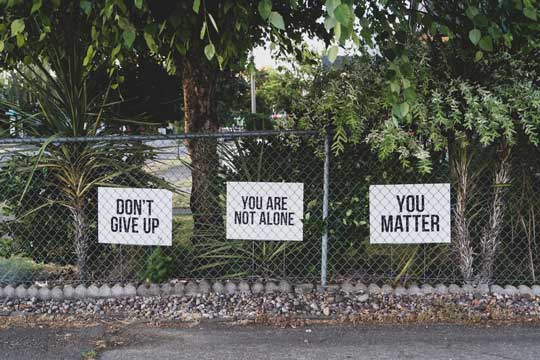When Alcoholics Anonymous began in 1935, it had two members: the founders. Today, it has over two million and over 125,000 different types of groups, catering to every alcoholic and addict in the world. It seems like something’s working, doesn’t it?
Sure, the world becomes embroiled in new battles with new forms of addiction every day. But, the truth of the matter is, it’s a spiritual battle. Once people enter into a 12 step program, they fight an internal struggle alongside comrades who will help them change their fate and start living again. Here are just a few of the reasons why twelve-step programs work.
1. They’re The First Point Of Hope
When you enter into a 12-step program, you’re going to meet a roomful of people just like yourself and most likely be handed a big book. There are many types of twelve-step programs spanning from narcotics anonymous to sex anonymous. Each focusing on some form of addiction treatment.
In 2017 alone, nearly 20 million American adults said they battled a substance use disorder or drug addiction. That means your future friends are fighting some of the same issues as you. They have a problem: they want to stop using drugs or drinking alcohol (or even many other behaviors that 12 step programs exist for), but they don’t know-how.
Meeting people that are “in the same shoes” as you always offer a token of comfort and hope. One person in that room will introduce themselves to you, take you by the hand, and open you to a world of hope – a world where change is possible.

2. 12 Step Programs Offer Accountability
Have you ever tried to quit alcohol alone? It didn’t go according to plan, did it? When we’re only accountable to ourselves, we can make up any excuse in the world for our failures. If you didn’t want to have a drink today, but you did, it’s easy to make a million different excuses for that.
In 2017, one in eight adults said they struggled with alcohol and drug disorders simultaneously. But, what about other addictions, like food, that is paired with alcohol? That’s not a battle you want to try to fight alone.
When you enter into a 12 step program, other people are going to be looking out for you. They’re even going to share similar stories regarding their multiple relapses. You’ll start to see two things happen here.
First, your friends won’t allow you to make up excuses. You relapsed, now it’s time to start walking through the steps again. Second, your friends won’t judge you for backsliding. They’ll understand your struggle and simply pick you up off the ground without a blink.
This makes it a whole lot easier to come back around again.
3. They Offer New Friendships
In the rooms of 12 step programs, you’ll make some of the most potent, lifelong, and everlasting friendships.
These people are your kin. Perhaps they’re highly sensitive, just like you. Maybe they had a traumatic childhood that sent them spiraling, much like your own experience. Perhaps they were born into a family full of addicts and are trying to break the cycle, something you strive to do, too.
These are connections you probably won’t find in the “real world.” But, the moment you step into a 12 step program, you’ll be presented with a roomful of future friends. Take people up on their offer to grab a coffee some afternoon.
Check out that 5 o’clock meeting with them tomorrow night. You’ll quickly see that these are “your people” and you’ll enjoy being around them.
The truth is, addiction is considered to be a highly treatable disease. Long-lasting recovery is possible. But, when you do it in the presence of a few like-minded friends, your odds become significantly higher.
4. They’re Practical
The 12 steps are as practical as they get. They force people to look in a mirror logically. This is why some people fail in the program. They’re not ready to look themselves squarely in the eye.
The first step of the program states that you’re powerless over your addiction. Gone are the days of saying, “I don’t have a problem.” There’s no more telling yourself, “It’s under control.” Now, addicts have to acknowledge that they’re powerless, and their lives have become unmanageable.
The second step allows members to see that they can’t keep doing the same thing over and over again, expecting a different result. However, they’re not out of their minds. They need a power greater than themselves to pull them out of the ditch.
Once recognition sets in, steps can be taken. In these steps, members make amends with some of the uglier patches of their lives (allowing them to release it and move on). They also take continual personal inventories. When resentments and other vicious battles arise, members can recognize their triggers and take steps to do the next right thing.
The awareness that comes with a 12 step program is an integral part of its success. Once members have walked through it all, they can pay it forward; they can share the message with others. Here are the 12 steps of Alcoholics Anonymous:
- We admitted we were powerless over alcohol – that our lives had become unmanageable.
- Came to believe that a Power greater than ourselves could restore us to sanity.
- We made a decision to turn our will and our lives over to the care of God as we understood Him.
- Made a searching and fearless moral inventory of ourselves.
- Admitted to God, to ourselves, and to another human being the exact nature of our wrongs.
- Were entirely ready to have God remove all these defects of character.
- Humbly asked Him to remove our shortcomings.
- Made a list of all persons we had harmed and became willing to make amends to them all.
- Made direct amends to such people wherever possible, except when to do so would injure them or others.
- Continued to take personal inventory and when we were wrong promptly admitted it.
- Sought through prayer and meditation to improve our conscious contact with God, as we understood Him, praying only for knowledge of His will for us and the power to carry that out.
- Having had a spiritual awakening as the result of these Steps, we tried to carry this message to alcoholics and to practice these principles in all our affairs.
Video Transcript
Video Transcript
5. They’ll Help You Pay It Forward
In the end, you’re not only positioned to help yourself, but you can also spread the message to others who are suffering. Be the person who takes newcomers by the hand and makes them feel welcome. Volunteer within your local 12 step group to host the monthly birthday parties when people receive their chips.
Consider one of the many volunteer opportunities within AA, such as the ability to take literature into the prisons. When we get out of our heads and start to focus on others, amazing things can happen (both for them and for us).
Consider a 12 Step Program Today
Why not give it a shot?
Considering a 12 step program simply means you’ll stick your head through the doorway and see what kinds of stories people are sharing. Maybe you’ll relate, maybe you won’t. (We bet you will, though.) Maybe you will form a connection with a higher power of your understanding.
Something like AA that’s stuck around for nearly 85 years must be doing something right. Otherwise, it would’ve collapsed by now. Give yourself a chance to heal. Sure, it might start with a difficult personal inventory, but it’ll end with healing and a tremendous support system.


Recent Comments